Chapter 1: What is Tableau Server?
Tableau Server is part of the Tableau business intelligence platform that provides a centralized location to store content, including dashboards, data sources, and much more. It can be used as a collaboration tool for product development and as a communication tool to distribute information to end users. It facilitates the interactive exploration of shared data visualizations and connections and automates tasks so that your content is up to date and convenient to access. In this context, content simply refers to reports and data sources that have been published to Tableau Server.
After completing this chapter, you should have a keen understanding of the basic structure of Tableau Server and how it interacts with other Tableau products. Additionally, you will learn about the various Tableau Server licenses, site roles, and permissions that are available and how they impact each other to dictate the user experience.
In this chapter, the following main topics will be covered:
- What is Tableau Server and why should I care?
- Examining Tableau's basic structure
- Understanding what a site is on Tableau Server
- Understanding licenses, site roles, and permissions
What is Tableau Server and why should I care?
Tableau Server is a web-based application that provides Tableau Desktop users with the ability to upload and store interactive dashboards and data sources within a centralized location. Once content has been published to Tableau Server, the owner has the ability to determine the individual users or groups who have access to it and to what extent. Content such as dashboards, worksheets, and stories can be easily shared by providing a hyperlink. This platform fosters and enhances collaboration, knowledge sharing, data exploration, and data communication.
This book has been written to benefit Tableau Server end users and content creators first and foremost. Learning how to navigate and leverage Tableau Server is the primary focus of this book. This book will help you to understand the tools that are used to drive the engagement and utilization of this amazing platform within your group or organization.
If you are reading this book, you might already be familiar with a Tableau product such as Tableau Desktop, Tableau Public, Tableau Prep, or one of the many other products the company offers. Conversely, you might have no experience with Tableau or any other data analytics or data visualization software at all and were just granted access. Whichever camp you fall into, this book can help you. Why? Well, this book is written for the majority of users: the people who create and publish content and the end users with whom this content is shared. It is not an expectation that the reader of this book is or plans to become a Tableau Server Administrator or possess the knowledge of a Tableau Zen Master.
This book is written for regular analysts and developers who just want to gain a better understanding of this product to increase their productivity, drive engagement, and increase the utilization of their data-driven products. The reasons for wanting to explore this topic can be multifaceted and varied: for self-growth, for the better dissemination of information, or to gain a competitive advantage. Whatever your goal with Tableau Server, this book will help.
Tableau Desktop is where data analysis and visualization take place. But then what? Next, you need to share this information with consumers. Historically, this has been done by sharing unsecured reports with static data in the form of a spreadsheet or slide. Tableau Server provides information to consumers via a more secure, interactive, and automatable process to accomplish a task.
There are several major benefits of Tableau Server, including the following:
- Automation: Instead of using a static report that needs to be updated every week, month, or quarter, you can connect to a report that has a live connection to your data or that updates at scheduled intervals selected by the creator of the report or Tableau Administrator.
- Customization: You can tweak an existing piece of content to your own specifications (for example, you can filter a report you use by default to only show a particular region when you log on) or edit a piece of content right on the server using the Web Edit feature.
- Data security: When your company hosts its own server, it allows itself to set up and alter the specifications based on the data privacy policies determined by your organization.
- Organization: You can have all of your data stored within a single location. This can help you to create a single source of truth for your data and reporting.
- Subscriptions: You can send an automated email to be delivered to selected users or groups who are interested in receiving a report. You even can schedule when the email is delivered so that it is sent after an extract refresh occurs to ensure email recipients are only being notified when a report contains the most recent data.
After completing this chapter, you should have a broader understanding of Tableau Server and how it relates to other Tableau products. You will also have a clear understanding of the different licenses, site roles, and permissions available and how they interact with one another. Let's begin by looking at Tableau's basic structure and where Tableau Server falls within it.
Examining Tableau's basic structure
The Tableau platform has a multitude of products and features to choose from to help you and your organization best utilize data to make informed decisions. These products can be integrated for an optimal experience and are flexible enough to adapt to your organization's needs. Because each product can be customized and utilized in so many ways, no two Tableau Server environments are exactly the same. Every organization has its own practices regarding data collection, storage, management, and access. Likewise, every organization will deploy the use of Tableau products and services to fit their data needs and culture. No matter the differences, there are some basic processes that apply to all who use Tableau Desktop and Tableau Server. This process is illustrated in Figure 1.1:

Figure 1.1 – The process of developing and sharing analytic insights with Tableau
In this section, we will examine each of these steps and the application of their corresponding Tableau products. Let's begin by gaining an understanding of data sources.
Data sources
Before any analysis takes place, first, you must connect to your data. You can do this from Tableau Desktop by connecting directly to your database or by connecting to a published data source on Tableau Server. The various types of Tableau data connections include the following:
- Data extracts: These refer to a subset, or snapshot, of data that is stored in Tableau file format, that is,
.hyperor.tde. (Note that you will only encounter a.tdefile format if you use a version of Tableau Desktop prior to 10.5.) These files are optimized for performance within Tableau. Extracts can be embedded in a workbook when publishing to Tableau Server and can be scheduled to refresh on a regular basis so that the data stays up to date. - Live connections: These allow you to query the database to update with real-time data. Every action performed in Tableau Desktop or Web Edit from Tableau Server initiates a query to the database.
Tip
While "real-time" data might sound ideal, in reality, your data source is rarely optimized to provide real-time performance. In fact, if the underlying data tables that you are connected to only update once a day, then real-time queries with a live connection from Tableau will not provide any new data until that initial data table has been updated. In this case, it would be best to use an extract. Likewise, if you have a slow live connection, you will benefit from creating an extract.
- Published data sources: These refer to a data source that has already been established using either a live connection or a data extract and then published to Tableau Server. Once on the server, a single published data source can be used by multiple workbooks to provide consistency, reliability, and efficiency.
You might find that the raw data available to you is not formatted in an optimal way nor is it clean enough to perform an accurate analysis. For example, there might be inconsistencies with the spelling or number formatting. When this occurs, your data should be cleaned before you begin your analysis using tools such as Tableau Prep or Alteryx. Once you have cleaned and prepared the data, you can establish a data connection in Tableau Desktop using one of the methods described earlier.
Tableau Desktop
Once you have established your data connection, you are ready to begin analyzing the data. This is where Tableau Desktop comes in. Tableau Desktop is a tool that allows users to explore and visualize their data for analysis, operational reporting, and more. Figure 1.2 shows the Tableau Desktop interface when it is connected to the included Sample – Superstore dataset that comes with Tableau:
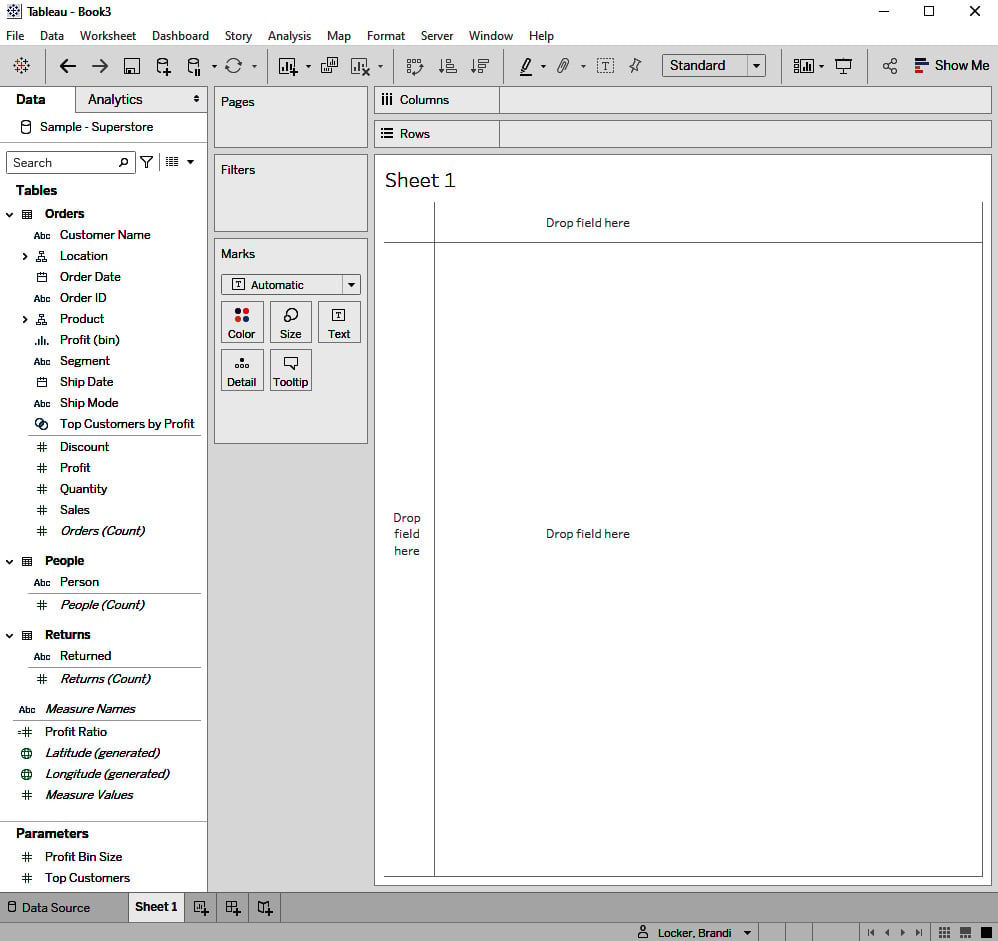
Figure 1.2 – Tableau Desktop
Using this interface, analysts using Tableau can create reports and data visualizations, known as dashboards, to share with others. An example of a dashboard is shown in Figure 1.3:
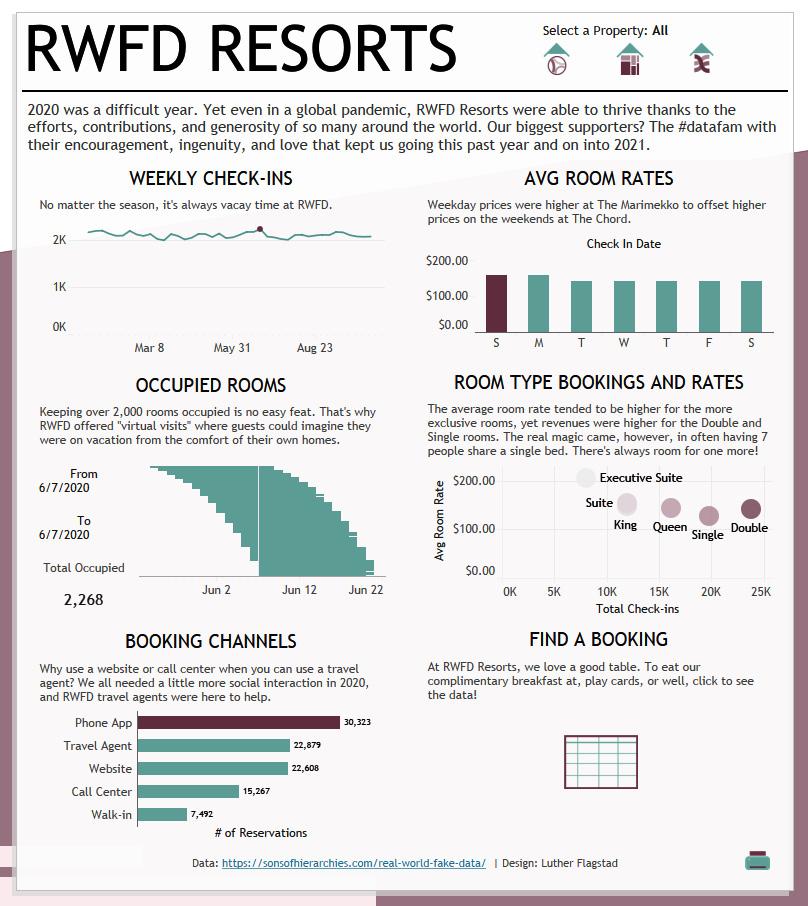
Figure 1.3 – A dashboard created by Luther Flagstad
Throughout this book, there are examples of dashboards created by individuals within the Tableau community. These examples highlight some of the community initiatives and resources that are available to anyone wishing to develop their data analysis and visualization skills further. You can learn more about the Tableau community by visiting https://www.tableau.com/community. We will also discuss these resources in more detail in Chapter 10, Conclusion.
Tip
To find inspiration and discover what Tableau can do, you can visit https://public.tableau.com and browse the gallery to see the Viz of the Day. Additionally, you can use the search feature to search for "superstore." This will allow you to browse Tableau Public to view some of the amazing data visualizations created by individuals within the Tableau community using the Sample – Superstore dataset.
There are a few terms used within this book that are commonly used on the Tableau platform that you need to be familiar with. Some of these are as follows:
- Worksheet: This refers to a single page within Tableau Desktop where a visualization (such as a chart, graph, or table) is created.
- Dashboard: This refers to a collection of worksheets containing charts, graphs, or tables that are arranged in a single view.
- Story: This refers to a sequence of worksheets or dashboards that are arranged to explain an analysis or to tell an informative story.
- Workbook: This is a Tableau file containing worksheets, dashboards, and stories. Files can be saved as a
.twbor.twbx:.twb: This is the default Tableau Desktop file type. The data source will not be embedded (available to other users who are sent a copy of the file)..twbx: This is a packaged workbook that has the data embedded within the file. This file type can easily be shared with others since they will be able to view and interact with the included data.
- View: This is normally used in a more general context as something that is viewed on the screen, such as a worksheet, dashboard, story, or metric.
Once your analysis is complete, these data creations can be shared with others within your organization using Tableau Server.
Tableau Server
As outlined in the previous section, Tableau Server provides a place to store and share data visualizations created in Tableau Desktop. It can be used as a communication tool to provide users with up-to-date information and alerts. There is also a feature known as Web Edit that allows you to make changes to the content on the server from your web browser. Your capabilities within the Web Edit feature will depend on your permissions.
You might encounter similar Tableau products that allow you to share data visualizations, such as Tableau Online and Tableau Public. Here is a quick overview of the Tableau products that enable you to publish and share your content:
- Tableau Server: This is a self-governed and self-hosted server that gives an organization full control and responsibility for managing its content and processes.
- Tableau Online: This provides the same functionality as Tableau Server but is fully hosted by Tableau for a hassle-free experience.
- Tableau Public: This is a free, public server that allows individuals within the Tableau community to practice and develop their data visualization skills and share that information with the world. Tableau Public can also be an excellent resource for non-profit organizations.
The purpose of this book is to examine the Tableau Server experience, but most of the principles learned here will also apply to Tableau Online. Tableau Public is a unique service that is simpler, free to use, and available to anyone. We will discuss how to connect and publish content to Tableau Server and Tableau Public in the next chapter, Chapter 2, How to Connect and Publish to Tableau Server.
Once content has been published to Tableau Server, it is ready to be shared with the end users.
End users
The end users are those users who use the data to make business decisions. This can include analysts, front-line management, business executives, and everyone in between. They require access to the insights provided by the data products. When a dashboard is created and published to Tableau Server, it is the end user who views the dashboard and determines what to do with the information and how it can impact the organization.
As an analyst, developer, or business partner, you can share content on Tableau Server with other users by sharing a URL or using the Share feature discussed in Chapter 8, Interacting with Views on Tableau Server. Throughout this book, you will learn how to best utilize Tableau Server in a way that optimizes your own efficiency and maximizes the value of your organization's server content for the business. End users can access the data through a web browser using their computer, tablet, or smartphone. Tableau Server is flexible enough to facilitate these needs and can be optimized for a variety of viewing methods.
So, you now have a basic understanding of the structure of the Tableau platform and how various content creators, and users interact with each component. The varying needs of these users will impact the way the server is used and managed. Understanding how other users interact with the server will help you to find ways to improve the end user experience and drive engagement with the content available on the server.
In the next section, we will review licenses, site roles, and permissions along with the impact they each have on the user experience.
Understanding what a site is on Tableau Server
To begin, what is a site on Tableau Server? Is it like a "website?" Nope. When it comes to Tableau, a site refers to a grouping of content and users that are blocked from other content and users using that same Tableau Server. Put simply, your company can have many sites on its Tableau Server, but you might only have access to a limited number of them. This is because Tableau Server has a multitenant software architecture. This just means that a single instance of software (Tableau Server) can support multiple tenants (sites) on a server. Ultimately, this means that the content you publish to one site is separated from the content on other sites within the same instance of Tableau Server.
Note
The content on Tableau Server is accessed, managed, and published at the site level. In addition to this, every site on Tableau Server receives its own web address (or URL).
In this brief section, you learned what a site is on Tableau Server. Having a solid understanding of what a site is will be useful in later sections of this chapter. Next, we'll get a broad overview of licenses, site roles, and permissions.
Understanding licenses, site roles, and permissions
The combination of all your permissions determines your capabilities on Tableau Server. Your license is the maximum level of permission, and every user on Tableau Server requires one. As a user, you receive a single site role for each site that you belong to. This site role restricts what you can do with the content. Finally, content permissions are the lowest level of permissions. These permissions are applied at an individual user or group level to different object types (such as a project, workbook, view, or data source) on a site, but they are constrained by your license and site role. This means that when changes are made to your content permissions, it is possible that they might not impact any of your existing capabilities if your license or site role already restricts them.
Figure 1.4 provides a high-level overview of the three levels of permissions in a descending hierarchy:
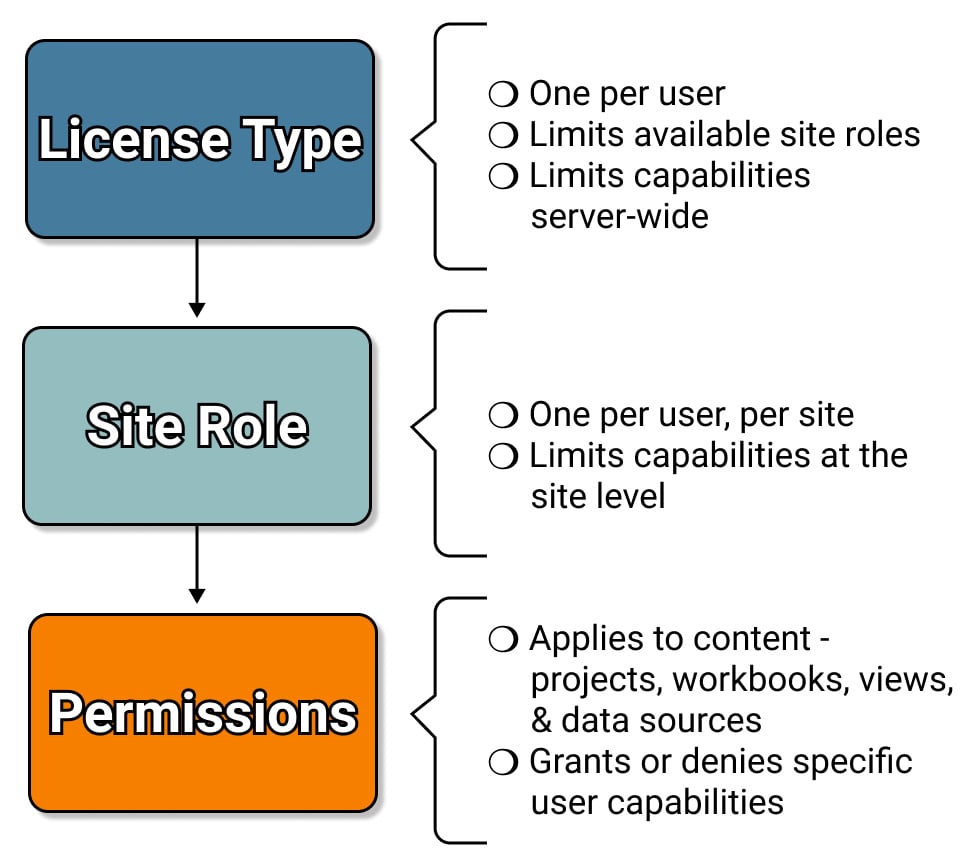
Figure 1.4 – An overview of the License, Site Role, and Permissions hierarchy
All users on Tableau Server require a license. As a user, you will receive a single license. Your license type is at the top of your capability's hierarchy, as it determines the limits of your abilities across the server, which, in turn, determines the limits of your capabilities on every site within that server. Put simply, the license you are assigned represents the maximum number of site role capabilities you can have on that server. There are three license types: Creator, Explorer, and Viewer. In the next section, we will go over each of these licenses in detail.
For each site that you belong to as a user, you will have a single site role. Your site role is restricted by your license type. This just means that the license you receive will place constraints on your capabilities at a site level. You can't have any capabilities at a site level that exceed the abilities provided by your license. There are eight types of site roles: Server Administrator, Site Administrator Creator, Site Administrator Explorer, Creator, Explorer (can publish), Explorer, Viewer, and Unlicensed. We will go over each of these site roles, in detail, later in this chapter. Just remember that your site role will limit your capabilities at a site level.
You have permissions to the content (such as projects, workbooks, views, or data sources) on a site that is restricted by what your site role allows. The permission rules assigned to you as a user, or to a group that you are a part of, determine your capabilities in terms of what you can do with a piece of content.
Note
It is important to remember that licenses and site roles apply to users, whereas permissions apply to content.
We understand that this can be a little abstract and confusing to follow at first. Don't worry. We'll go over licenses, site roles, and permissions separately, and in greater detail, before we tie everything back together at the end of the chapter.
License types
In the previous section, we briefly touched on license types. As a reminder, licenses apply to users, not content. You will receive a single license on a server, regardless of how many sites exist on that server. The license you are assigned represents the maximum site role level a user can have on that server.
Figure 1.5 provides an example of the dynamics of each license type:
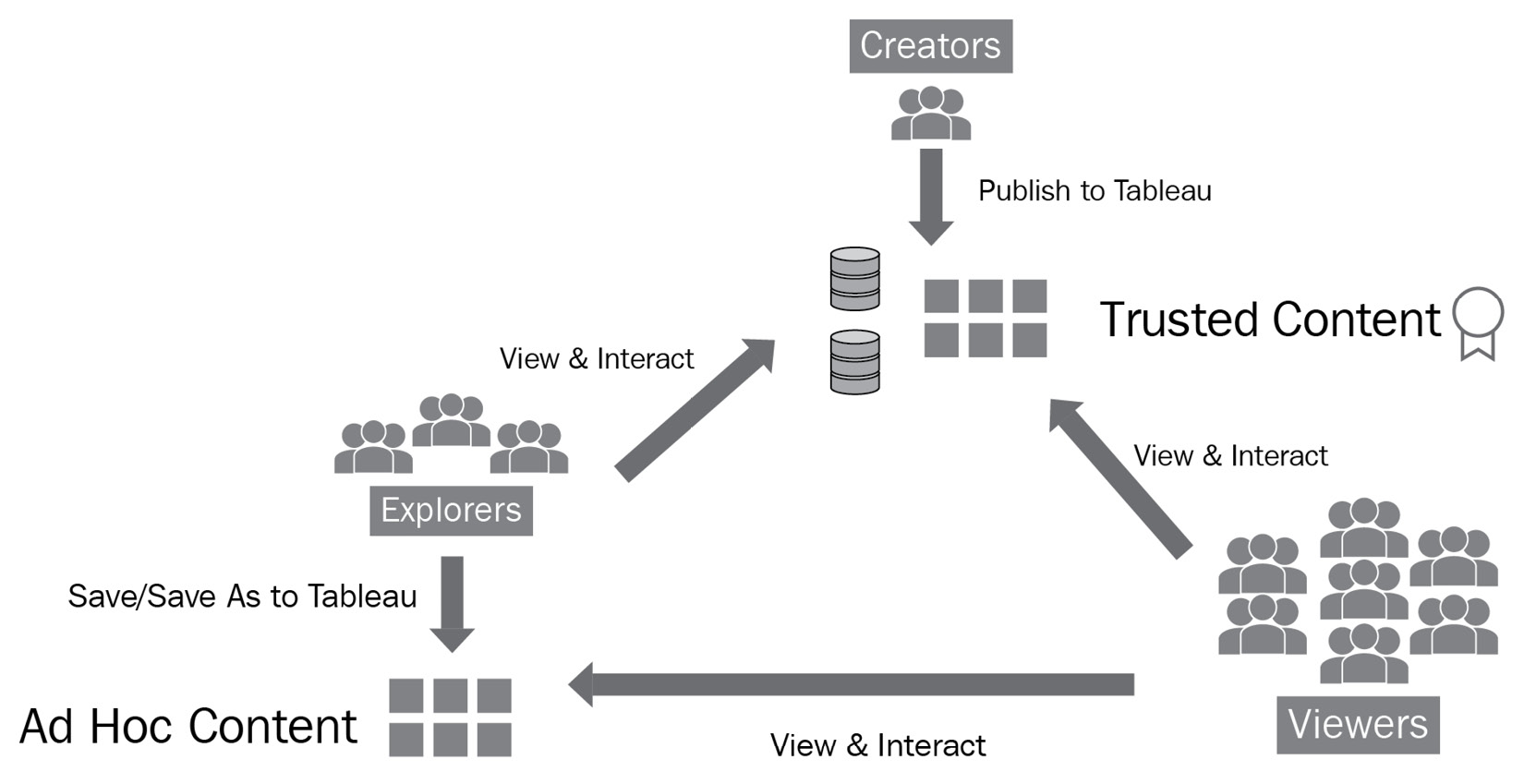
Figure 1.5 – An overview of the license types
Next, we'll review each of the three Tableau Server license types from the highest level of access to the lowest level of access:
Creator license: This is the highest license type available and is intended for people who make content. Making content includes everything from designing dashboards to developing data sources. As the name of the license suggests, individuals who receive this license will be responsible for the creation of most of the data sources and any other content utilized by your organization.
Explorer license: This license type is primarily intended for people who analyze content. Individuals who receive this license are able to access and examine content published to Tableau Server. Users with an Explorer license are likely to be accustomed to working with data and developing ad hoc reports to ask and answer questions.
As a user with an Explorer license, you can create, manage, and share your new workbooks and dashboards using data sources published to Tableau Server. Additionally, you can edit existing dashboards or make your visualizations via the Web Edit feature on Tableau Server using data sources created by other users for which you have been granted access. From a Tableau Server perspective, the only difference between an Explorer license and a Creator license is that with an Explorer license, you cannot create data sources.
Viewer license: This license type is primarily intended for individuals who want to view and interact with published content. Users with this license have the ability to interact and engage with dashboards and workbooks but not create them. In addition to this, users with a Viewer license can subscribe to dashboards to receive regular updates and set data-driven alerts.
Figure 1.6 provides a breakdown of the capabilities of each license type:
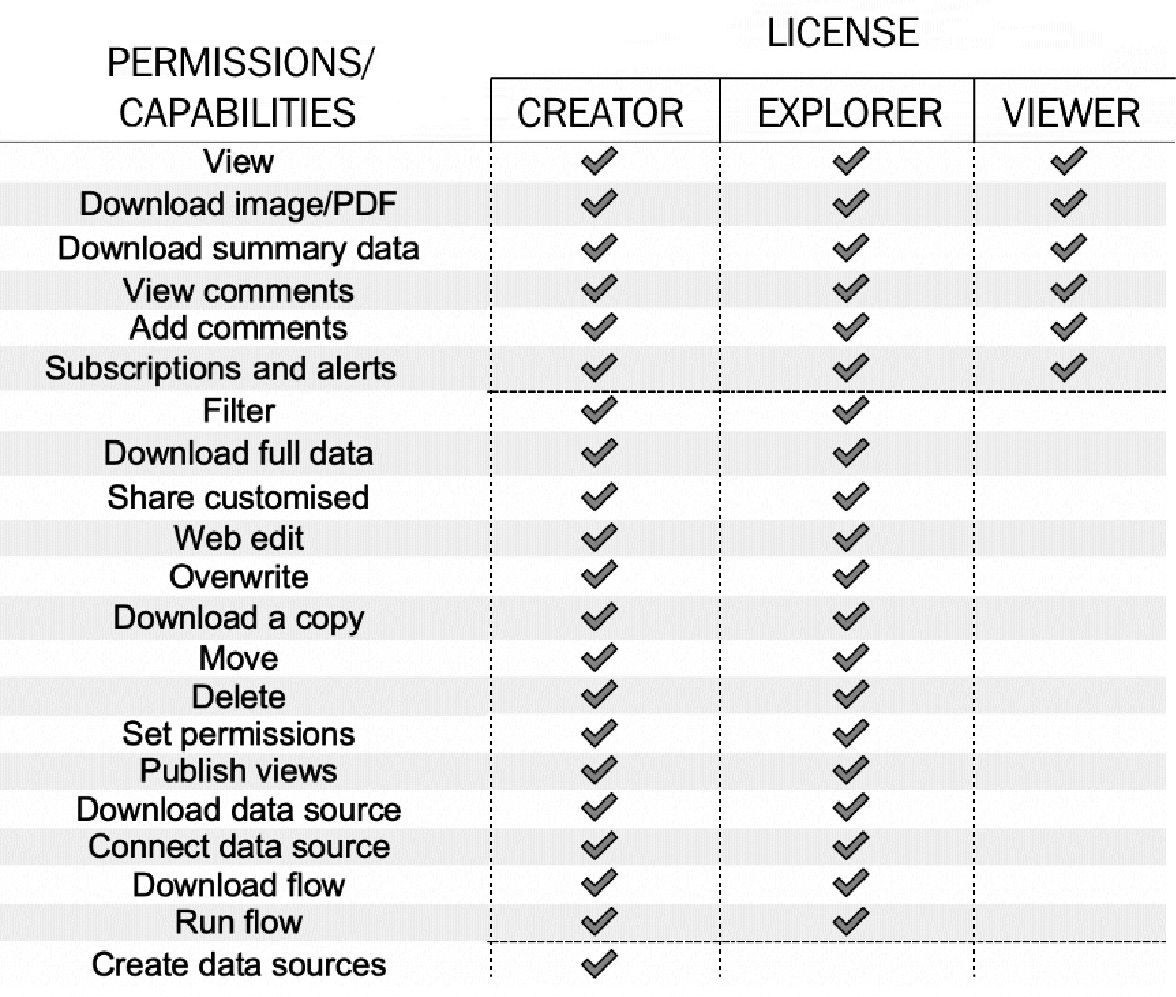
Figure 1.6 – Tableau license capabilities
Tip
Your license is at the top of the permissions hierarchy in Tableau Server, so make sure that the license you receive provides you with the permissions you will need. It's likely that your company has a limited number of Tableau licenses, so talk to your manager or Tableau Server Administrator if you believe that you should have a different one.
Site roles
Earlier in this chapter, we briefly discussed site roles. As a reminder, site roles apply to users, not content. You will have a single site role for each site to which you are a member, and your site role will be restricted based on the type of license you are assigned by your Server Administrator.
Let's review each of the eight Tableau Server site roles from the highest level of access to the lowest level of access:
- Server Administrator: This is the highest site role available and uses a Creator license. It allows complete access to Tableau Server, including access to all content. Server Administrators can add users and set their site roles. They have the ability to create projects and set permissions for all users. They also have full editing and saving rights to all workbooks. Additionally, they can create sites, add users to those sites, and assign Site Administrator site roles to users.
- Site Administrator Creator: This site role is assigned by a Server Administrator to a user with a Creator license to help delegate creating and managing the user and content framework of an individual site. These users can add server users to their site. Within their site, they can create groups, projects, assign permissions, schedule extract refreshes, and have full editing and saving rights to all workbooks on their site. Finally, this site role can also publish content to the server.
- Site Administrator Explorer: This site role is assigned by a Server Administrator to a user with an Explorer license to help delegate creating and managing the user and content framework of an individual site. These users can add server users to their site. Within their site, they can create groups, projects, assign permissions, schedule extract refreshes, and have full editing and saving rights to all workbooks on their site. Unlike the Site Administrator Creator site role, this site role cannot publish content to the server.
- Creator: This site role is assigned to users with a Creator license. The default permissions for these users can publish content to Tableau Server and edit, download, and save content on the server. These abilities represent the maximum level of access for Creators' permissions and can be changed by a Site Administrator.
- Explorer (can publish): Users with this site role possess, at the very least, an Explorer license. The default permissions for these users allow them to save changes made to content via the Web Edit feature; however, they cannot publish new data sources to Tableau Server from Web Edit. Again, these abilities can be restricted by a Site Administrator.
- Explorer: Users with this site role possess, at the very least, an Explorer license. This site role can open dashboards on Tableau Server using Web Edit. Users can analyze and explore the data by making edits and building new views; however, users cannot save these changes. Again, these abilities can be restricted by a Site Administrator.
- Viewer: Users with this site role possess, at the very least, a Viewer license. This site role allows users to view content in the format it was published. They can interact with dashboards, but they cannot access the Web Edit function.
- Unlicensed: Users with this site role cannot edit or view any content on Tableau Server. The purpose of the Unlicensed site role is largely for users who have left a company or changed departments. The user owns the content that they create and publish to a server. As a result, any content associated with a user will be removed when they are deleted from the server. This role type allows the accounts of ex-coworkers to still exist and for their content to continue to be accessed by other users.
In this section, you learned about site roles. We examined each available site role in detail. Next, we'll take a look at the different combinations of licenses and site roles that are available.
Take a look at the following link to view all license and site role combinations: https://help.tableau.com/current/server/en-us/users_site_roles.htm#tableau-site-roles-as-of-version-20181.
Figure 1.7 shows the capabilities of each license and site role combination:
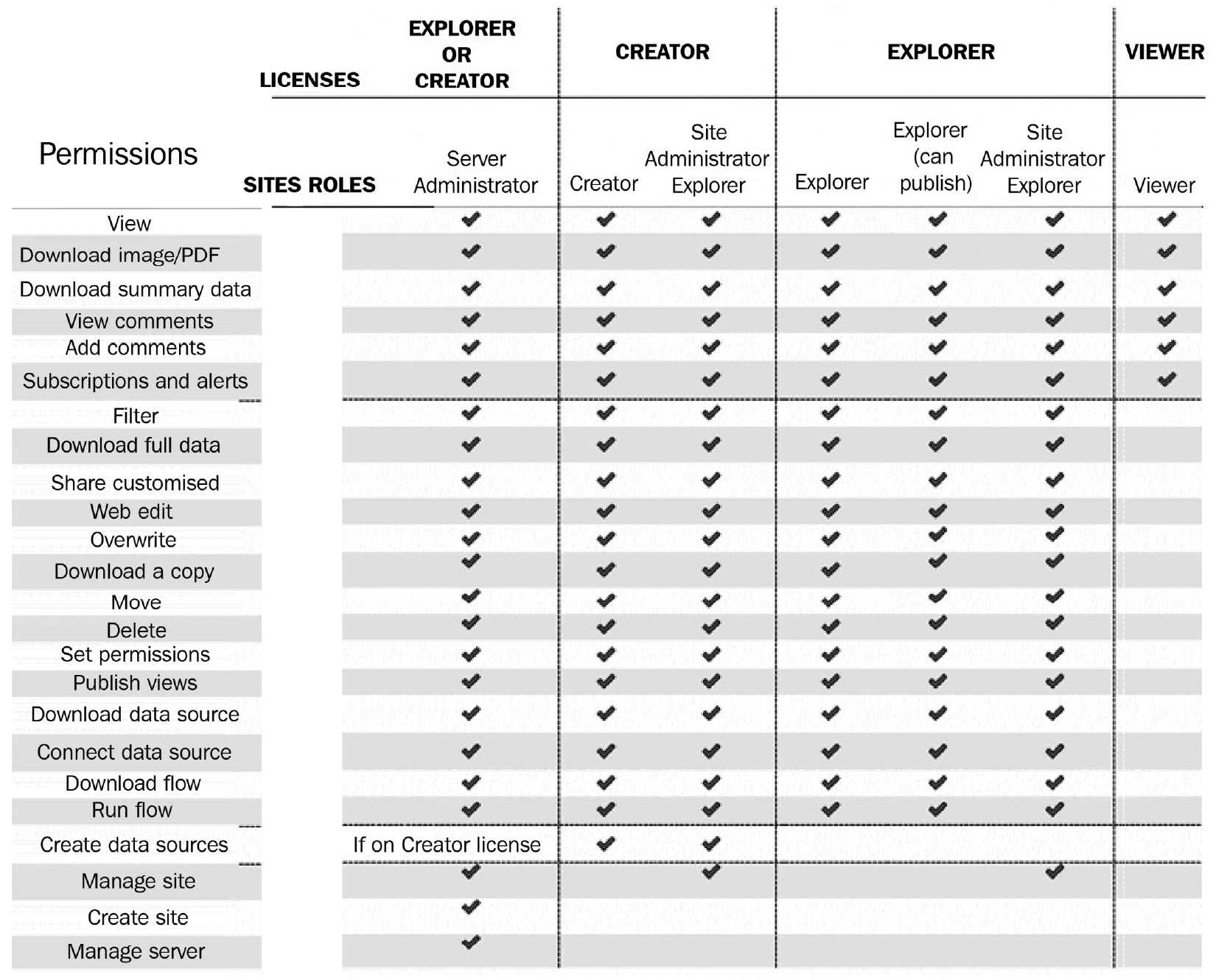
Figure 1.7 – License and site role capabilities
Permissions
Permissions determine how users can interact with content (such as projects, workbooks, views, and data sources). The capability to filter, utilize Web Edits, delete, and download full data is granted to users or groups on a specific piece of content.
To make applying permissions rules quicker and easier, Tableau Server provides the ability to select several predefined permission templates. You can select permission templates for Administrator, Publish, Explore, and View. An example of the permissions provided by these predefined templates is shown in Figure 1.8:
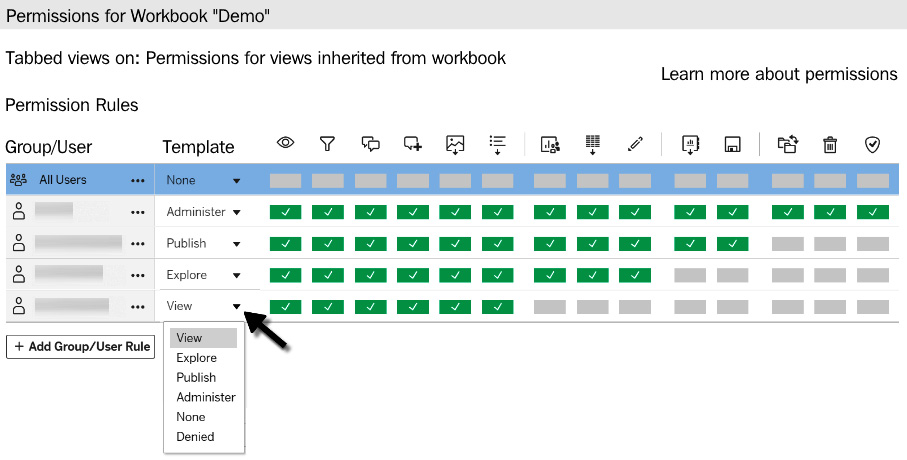
Figure 1.8 – Predefined permissions templates
Permission rules determine the capabilities that you as a user or group member are allowed or denied access to on a piece of content. The predefined permissions templates have set permission rules. If you make and save any changes to a predefined permission template, it will change into a "Custom" role. In addition, you can create your own "Custom" roles from scratch. This is because there is always the option to manually assign specific capabilities to users or groups instead of using one of the predefined options. You can accomplish this by selecting each capability you want to grant or deny an individual or group on the Permission Rules page. In Chapter 7, What is in the More Actions (…) Menu, we dedicate an entire section to reviewing the fundamentals of permission settings.
Tip
Whenever it is possible, we recommend that you set permissions at the project level and use groups when assigning permissions. Managing permissions rules at a project level is much easier than at the content level. Additionally, setting permissions to all users within a group is much quicker and more efficient than assigning them per user. Also, when new users receive access to Tableau, you can easily add them to the group(s) that provide them with the proper access.
Finally, it's helpful to understand that individual permissions rank higher than groups in the hierarchy of permissions. This means that it is more important to have a capability granted or denied at an individual user level than at a group level. Finally, a user can be a member of many groups. If a user is a member of two or more groups being granted permissions on a piece of content and any of those groups are denied a capability, this user will be denied that capability.
In this section, you learned about permissions. We touched on predefined permissions, manually assigned permissions, and the dynamics of individual versus group permissions. Next, let's take a look at how licenses, site roles, and permissions tie together.
How licenses, site roles, and permissions tie together
To recap what we've discussed regarding licenses, site roles, and permissions, let's organize what we've learned in a hierarchy from the highest user capabilities to the lowest user capabilities:
- User license: Your license type is at the top of the hierarchy when determining your capabilities across the entire server.
- Site role: Your site role is below your license in the user capabilities hierarchy. You receive one site role per site. The site role that you receive will be restricted by your license type.
- Content owner/project leader: Owning a piece of content or project is next in the hierarchy below the license and role type. You become a Content Owner by publishing a piece of content to the server, having ownership transferred to you, or by being assigned a content owner role by a Server Administrator, Site Administrator, or Project Owner. As a content owner, you have full access to the content you publish to the server. If the Project Owner allows for content permissions to be customizable, then a content owner will have the ability to modify content permissions. A content owner becomes Project Leader the moment they publish an object to Tableau Server, but not every project leader is a content owner. This is because content published to the server can have many project leaders, but only one content owner.
- Content permissions locked or customizable: The content permissions setting can be set in two ways, either locked or customizable. To configure content permissions, you need to be logged into a site as an administrator, project owner, or project leader. Locked Content Permissions means that a content owner cannot modify the permission rules on their content. As a result, the content will reflect the permission rules of the project, and the content-level permissions cannot be modified. The project owner has control over the permissions for the project and all its underlying objects. Customizable Content Permissions means that a content owner can modify content permissions for users or groups.
- Individual permissions: These permissions are applied to a specific user, and they determine how that user can interact with the content (such as projects, workbooks, views, and data sources). Permissions assigned to an individual rank higher in the hierarchy of permissions than permissions assigned to a group.
- Group permissions: These permissions are applied to a group of users, and they determine how they can interact with the content (such as projects, workbooks, views, and data sources). A user can be a member of many groups. If a user is a member of two or more groups that are being granted permissions on a piece of content and any of those groups are denied a capability, it will result in that user being denied that capability.
Figure 1.9 visually presents the hierarchy of user object capabilities from the highest to the lowest, as we just discussed:

Figure 1.9 – Hierarchy of the user's object capability
In this section, you learned how licenses, site roles, and permissions interact with and impact one another on Tableau Server. We examined the different license types and site roles that are available and their possible combinations. Additionally, we examined permissions, their rules, predefined roles, and custom roles. Lastly, we looked at how all of these varying levels of permissions tie together.
Summary
In this chapter, you learned about the Tableau platform, its most popular products, and how they work together. You also learned what a site is and how a single instance of Tableau Server can have multiple sites to help your organization manage its content. Finally, you learned about the available Tableau product license types and which type is required for your role within an organization, the difference between site roles and permissions settings for server content, and how all of these things work together to determine what you can do within your Tableau Server environment. The principles learned in this chapter set the foundation for the remainder of this book, as well as how you interact with Tableau Server and its content.
In the next chapter, you will learn how to connect to Tableau Server and Tableau Public, how to publish content to each platform, and how to determine at which level to manage various settings.




















